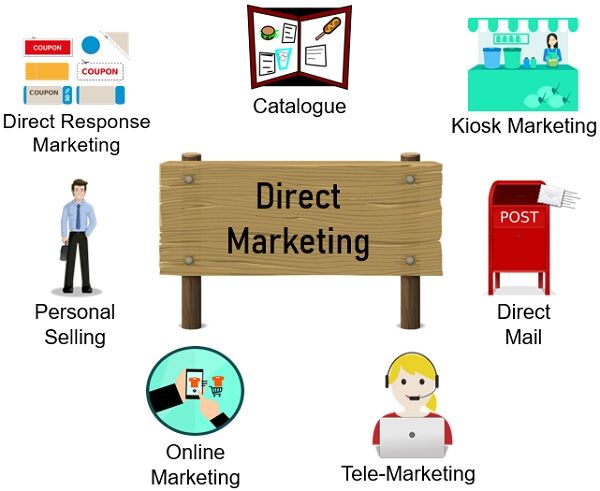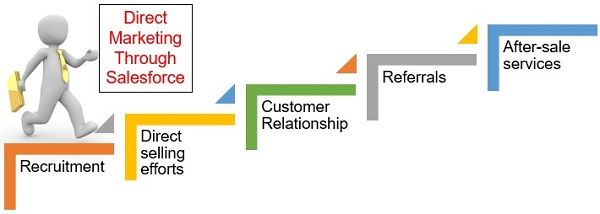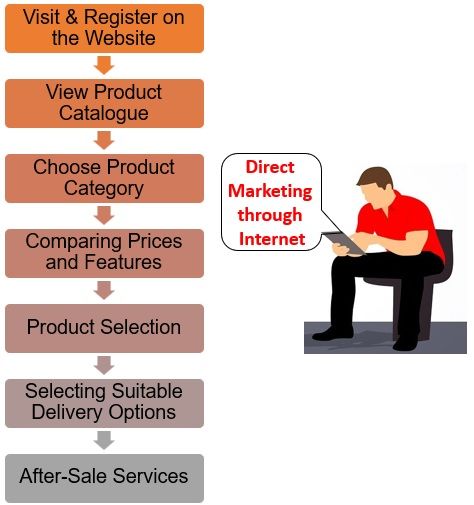Definition: Direct Marketing is a personalized form of marketing that establishes direct interaction with the potential customer. Here, the marketers target the correct type of audience for promoting their products. Its goal is to get a response from the target customer.
However, it does not necessarily involve physical interaction with the customer. Besides, companies may use alternate mediums like- online platforms, print media, etc.
It is also known as Direct Selling/Mail Order Selling/Catalogue Selling.

Direct Marketing uses two-way or personalized communication to reach its prospective customers. This is because, personal interaction with customers facilitates impactful sales. Also, it enhances customer satisfaction and post-sale experiences.
It excludes intermediaries from the marketing process. The non-involvement of mediators leads to cost reduction by eliminating extra margins. Further, it results in a reduction in the prices of the final product.
Direct marketing has grown drastically due to Globalization and accelerated Internet usage. It aims to:
- Target Correct Audience
- Exclude Middlemen
- Cut Extra Costs
- Reach Large Potential Markets
Content: Direct Marketing
Types of Direct Marketing
The different types or tools of direct marketing are discussed below:
- Direct Mail
- Direct Response Marketing
- Mail-Order/Catalogue
- Door-to-Door Marketing/Personal Selling
- Tele-Marketing
- Kiosk Marketing
- Online Marketing
Direct Mail

Here, companies send mail directly to the target customer’s address. In addition, marketers are highly particular about their audience.
In direct mail marketing, the mail is sent in the form of Free Samples, Letters, and Postcards. Companies use it for making:
- Reminders
- Announcements
- New Product Releases, etc.
Example: Companies post free samples of their new product to their existing customers.
Direct Response Marketing

Marketers use this type of marketing when they seek an immediate response from the customer. The companies may use any possible channel for this purpose. The marketers run attractive campaigns intending to close the deal right away.
Example: Reliance Fresh offers special deals and discounts during the festive season. They use SMS, Newspaper ads, In-store announcements and Pamphlets for marketing.
Mail-Order/Catalogue

It involves the compilation of the company’s products in detail. The customers can place their order directly to the company through these catalogues.
It can be prepared according to the target audience like:-
- B2B Catalogues
- Customers Catalogues
- E-Catalogues, etc.
Example: Companies like Amway provides their product catalogues to their prospects. The Customers can choose among several products and place an order as required.
Door-to-Door Marketing/Personal Selling

Here, marketers approach their prospective clients through client meetings. It is a more personalised and effective type of direct marketing. Also, product demonstration and explanation at the client’s place help close the deal.
Example: Byju’s approaches its target customers by demonstrating its kit at the customer’s place. The kit contains a bag, study material, badge, chip and a tablet.
Tele-Marketing

Here, marketers communicate with their customers via telephone or call centres. Tele-marketing reduces costs and enhances customer satisfaction. Companies either go for Inbound Telemarketing or Outbound Telemarketing.
- Inbound Telemarketing
Calls received by the company from the customers in response to any marketing campaign. For Instance, a company accepts orders through calls in response to its advertisement published in the newspaper. - Outbound Telemarketing
Calls made by the company to the customers for a marketing campaign. For Instance, banks promote their financial products like credit cards through Telecalling.
Kiosk Marketing

Kiosks are the informative corner of the company placed in an area with high footfall. It can be in the form of Stalls, Canopy or Machines. Companies representative provides information about the product and facilitates sales on the Kiosk.
For Instance, installation of stalls or standees of different brands at shopping malls.
Online Marketing

In online marketing, marketers use web-based/online platforms to attract customers. Online marketing helps companies to reach global markets.
Marketers can promote their products over the Internet by:-
- E-mails
- Social Media
- Websites
- Online Advertisements
- Applications
Example: Many brands are promoting their products over social media platforms like Instagram.
Advantages
Following are the advantages of direct marketing:
- Interactive
Since direct marketing involves two-way communication, it is an interactive activity. - Secrecy
In direct marketing, the salesperson can maintain confidentiality about their marketing strategy. - Cost-efficient
It is cost-efficient for the companies as it excludes mediators or intermediaries. - Trouble-Free
It involves direct interaction with the customers. Consequently, the process becomes less complex. - Retain Existing Customers
It is easy to retain existing customers due to the enhanced customer service experience. - Focused Marketing
The marketers are well aware of the needs of the prospective customers. They can form strategies based on the feedback received by the customers. - Effective communication
Due to fewer channels in the marketing process, companies can communicate effectively.
Disadvantages
Following are the disadvantages of direct marketing:
- Irritation
Customers may get irritated by the approaches of the salesperson. - Unfair
Some marketers may manipulate the buyer or take advantage of the uneducated ones. - Fraud
A salesperson may deceive customers by exaggerating product features. - Invasion of Privacy
Companies may sell the buyers’ personal information, like – E-Mail ID and Number. - Time-taking
The marketer needs to approach its prospects until he is convinced to buy that product which is a time taking process. - Patience
The salesperson needs patience while demonstrating the product and satisfying customers’ queries.
Direct Marketing Model
The direct marketing model is based on the multilevel or network marketing approach. There are two types of models available based on:
- Salesforce
- Internet
Direct Marketing through Salesforce:

- Step 1: Recruitment of salesforce.
- Step 2: Direct selling efforts by the salesperson.
- Step 3: Generate relationships with customers.
- Step 4: New customers through referrals.
- Step 5: After-sale services.
Direct Marketing through the Internet:

- Step 1: Encourage customers to visit & register on the company’s website.
- Step 2: Customers get access to the product catalogue and deals.
- Step 3: Customers can choose the product category according to their needs.
- Step 4: Comparison of prices and features from that category.
- Step 5: Complimentary product review and product selection.
- Step 6: Selection of appropriate mode, date & time of delivery.
- Step 7: After-sale services.
Example
Whatsapp has emerged as an excellent platform for companies to approach their target customers. Many big brands like – Meesho, Ajio, Purplle and small vendors are using Whatsapp as a marketing tool.
The companies are promoting their products using:
- Product images
- Catalogues
- Posting on Whatsapp Status
- Accepting orders and tracking the delivery
- Accepting and receiving payments
- Sharing offers and deals on chat groups
- Forwarding product information to referrals.
Final Words
Direct marketing is an interactive process of approaching potential customers. The communication takes place directly with the customer and excludes intermediaries.
For this purpose, firms use channels like telemarketing, personal selling, and online selling. And, the customer responses are taken in the form of feedback. After that, companies can plan their campaign based on customers’ feedback.
Amy Saunders says
You know what? You’re totally spot on when you mentioned that direct marketing is indeed cost-effective since we don’t have to rely on numerous middlepersons. My boss has been asking me to find worker who can promote our business around my neighbourhood without draining our already tight budget. I’ll keep this tip in mind so we’ll be able to achieve our target very soon.